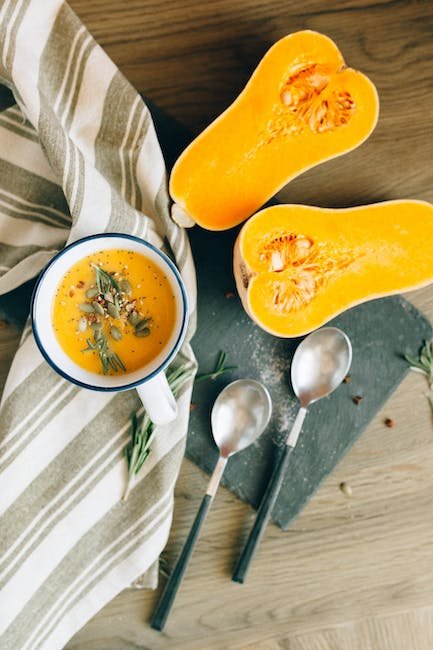Are you a new parent seeking to provide the best nutrition for your precious little one? Look no further, for we have the perfect solution! Making your own baby food at home is not only a rewarding experience but also ensures that your bundle of joy receives the most nutritious start in life. With a touch of creativity and a dash of love, you can easily whip up a variety of wholesome meals tailored specifically to your baby’s needs. Get ready to embark on a culinary adventure filled with vibrant colors, delightful flavors, and endless possibilities! In this article, we will guide you through the magical world of homemade baby food, sharing essential tips, recipe ideas, and everything you need to know to nourish and delight your little gourmet. Say goodbye to store-bought jars and embrace the joy of creating fresh, nutritious meals from scratch – your baby will thank you for it!
Table of Contents
- Start with Fresh Ingredients
- Puree and Blend for Texture
- Add Essential Nutrients
- Store Properly for Future Use
- Create Variety in Flavors
- Q&A
- Wrapping Up

Start with Fresh Ingredients
When it comes to cooking, there’s a simple yet essential rule to follow: . The quality and freshness of the ingredients you use can truly make or break a dish. Not only do fresh ingredients bring out the flavors in your recipes but they also provide vital nutrients and ensure a healthier, more enjoyable meal.
So, why should you prioritize using fresh ingredients in your cooking? Let’s take a look:
- Enhanced flavors: Fresh ingredients possess vibrant flavors that can elevate your dishes to a whole new level. Whether it’s a juicy tomato bursting with sweetness or fragrant herbs that add a burst of freshness, using fresh ingredients will bring out the best taste in every bite.
- Health benefits: Fresh ingredients are packed with essential nutrients, vitamins, and minerals that are vital for your overall well-being. By incorporating fresh fruits, vegetables, lean proteins, and whole grains into your meals, you can fuel your body with the goodness it deserves.
- Support local producers: Opting for fresh ingredients from local farmers and producers not only benefits your community but also helps reduce the carbon footprint associated with long-distance transportation. Plus, it’s a wonderful way to connect with your region’s seasonal produce and enrich your culinary experiences.
Whether you’re a seasoned chef or an aspiring home cook, embracing fresh ingredients is a surefire way to create memorable meals that are not only delicious but also nourishing. So, next time you step into your kitchen, remember to fill your shopping cart with the freshest produce, highest-quality meats, and freshest herbs for a sensational feast!

Puree and Blend for Texture
When it comes to achieving the perfect texture in your recipes, pureeing and blending can be your secret weapons. By breaking down ingredients into a smooth and creamy consistency, you can transform ordinary dishes into culinary delights.
One of the advantages of pureeing and blending is the ability to incorporate a variety of flavors and ingredients into your creations. From vibrant vegetable soups to velvety fruit smoothies, the possibilities are endless. Plus, by pureeing fruits and veggies, you can create a hidden boost of nutrients for those picky eaters in your life.
Here are a few tips to make the most of your pureeing and blending adventures:
- Experiment with textures: Varying the length of blending time can lead to different consistencies. Whether you prefer a silky sauce or a chunky salsa, adjusting the blending process can help achieve your desired texture.
- Combine flavors: Don’t be afraid to mix and match! Blending fruits with herbs or vegetables with spices can create unique flavor combinations that elevate your dishes from good to gourmet.
- Consider the tools: Invest in a high-quality blender or food processor to ensure smooth and efficient results. A sturdy appliance with different speed settings can handle everything from purees to smoothies with ease.
Remember, pureeing and blending opens up a world of culinary possibilities. So, grab your favorite ingredients, unleash your creativity, and blend your way to tantalizing textures and unforgettable flavors.

Add Essential Nutrients
When it comes to maintaining a healthy lifestyle, adding essential nutrients to your diet is crucial. These are the building blocks that provide your body with the necessary tools to function properly and stay strong. Whether you are looking to boost your immune system, improve your energy levels, or support your overall well-being, incorporating these nutrients into your daily routine should be a top priority.
One vital nutrient that should be on your radar is omega-3 fatty acids. Found in fatty fish like salmon and trout, as well as chia seeds and walnuts, these healthy fats offer a wide range of benefits. Omega-3s have been linked to reducing inflammation in the body, promoting brain health, and even supporting heart health.
In addition to omega-3s, vitamin C is another essential nutrient that plays a key role in maintaining optimal health. Fruits high in vitamin C, such as oranges, strawberries, and kiwi, are excellent sources. This powerful antioxidant not only boosts your immune system but also contributes to collagen production, which promotes healthy skin and joint health.
Dietary fiber is often overlooked but is equally important for overall well-being. High-fiber foods, like whole grains, legumes, and vegetables, help maintain a healthy digestive system, regulate blood sugar levels, and promote heart health. Including these fiber-rich foods in your diet can help prevent constipation and lower the risk of chronic diseases, such as diabetes and heart disease.
Remember, a well-rounded diet that incorporates a variety of essential nutrients is key to maintaining optimal health. By consciously adding these important building blocks to your daily meals, you are providing your body with the tools it needs to thrive.

Store Properly for Future Use
Ensuring that you store your belongings properly is essential for their longevity and future use. Here are some tips for storing your items in the best possible way:
- Sort and categorize: Before storing your items, take the time to sort and categorize them. This will make it easier to locate specific items in the future and prevent unnecessary damage caused by rummaging through cluttered containers.
- Protect with appropriate containers: Selecting the right containers is crucial to safeguarding your belongings. Glass items, for example, should be packaged in bubble wrap or placed in padded boxes to prevent breakage. Sturdy plastic bins are excellent for protecting fabrics and clothing from moisture and pests.
- Label and document: Labeling each container is key to staying organized. Include a brief description of the contents and any other useful information, such as fragility or weight. Additionally, consider taking photographs of your stored items for a visual inventory, aiding easy retrieval in the future.
- Utilize suitable storage spaces: Depending on the nature of your belongings, choose appropriate storage spaces. For example, temperature-controlled areas might be necessary for sensitive electronics and artwork, while a dry and ventilated basement might be suitable for long-term storage of frequently used items.
- Maintain conditions: Periodically check on your stored items to ensure the conditions remain optimal. It is important to keep an eye out for any signs of damage caused by pests, moisture, or decay. Also, consider rotating any perishable goods to prevent spoilage.
By following these storage tips, you can rest assured that your belongings will be well-preserved and ready for use whenever you need them in the future.
Create Variety in Flavors
The world of flavors is vast and ever-evolving, with countless possibilities waiting to be explored. Creating variety in flavors is an art of its own, allowing us to indulge in a multitude of sensory experiences that tantalize our taste buds.
One way to is by combining unexpected ingredients that complement each other. Whether it’s a dash of spicy chili in a sweet dessert or a hint of tangy citrus in a savory dish, these unexpected combinations can elevate the taste to new heights.
Another way to add variety in flavors is by experimenting with different cooking techniques. From grilling and frying to steaming and baking, each method brings out unique flavors, textures, and aromas. By utilizing these techniques creatively, you can transform ordinary ingredients into extraordinary culinary delights.
Furthermore, incorporating a wide range of herbs and spices can significantly enhance the flavor profile of any dish. From the warmth of cinnamon to the freshness of basil, these aromatic additions can take your taste buds on a journey around the world, giving each dish its own distinct character.
Finally, don’t forget about the power of presentation. A visually appealing dish can make the flavors seem even more tantalizing. Play with colors and textures, garnish with fresh herbs or edible flowers, and let your creativity shine.
Step out of your comfort zone and explore the vast array of flavors that the culinary world has to offer. With a little creativity and experimentation, you can create a symphony of tastes that will leave your guests craving for more.
Q&A
Q: Why should I make baby food at home instead of buying it from the store?
A: Making baby food at home allows you to have full control over the ingredients, ensuring that your little one receives the freshest and most nutritious meals. Plus, it can be more cost-effective in the long run!
Q: Can I use regular kitchen tools to make baby food?
A: Absolutely! You don’t need fancy equipment to make baby food. A blender or food processor, a steamer, and a fine-mesh strainer are all you need to create delicious and nutritious meals for your little one.
Q: What are some key nutritional guidelines to keep in mind when making baby food?
A: When making baby food, it’s important to introduce a variety of fruits, vegetables, grains, and proteins. Ensure the food is soft, easy to swallow, and free from any added salt or sweeteners. Remember to consult your pediatrician for any specific dietary requirements.
Q: How can I introduce new foods to my baby?
A: Gradual introduction is key. Start with single-ingredient purees and allow your baby a few days to adjust before trying a new food. This helps to identify any potential allergies or sensitivities and allows your baby to develop a taste for different flavors.
Q: Can I freeze homemade baby food?
A: Absolutely! Freezing baby food in ice cube trays or freezer-safe containers is a great way to preserve it for future use. Just make sure to label and date the containers, and consume within three months for optimal freshness.
Q: How can I ensure my homemade baby food is safe to eat?
A: Proper hygiene is crucial. Always wash your hands, utensils, and surfaces thoroughly before preparing baby food. Remember to cook foods to the appropriate internal temperature and discard any leftovers that have been sitting at room temperature for more than two hours.
Q: Are there any foods I should avoid giving my baby?
A: Yes, there are a few foods to avoid in the first year due to their potential for allergies or digestive issues. These include honey, cow’s milk, nuts, shellfish, and added sugars or artificial sweeteners. Consult your pediatrician for a comprehensive list.
Q: How can I add more flavor to homemade baby food without using salt or sweeteners?
A: Herbs and spices can be introduced gradually to enhance the flavor of baby food without the need for salt or sweeteners. Experiment with small amounts of spices like cinnamon, cumin, or basil, but always be mindful of potential allergic reactions.
Q: Can I combine different fruits and vegetables to create new flavors?
A: Absolutely! Mixing various fruits and vegetables can provide a wide range of nutrients and introduce exciting new tastes to your baby. Just make sure to pair ingredients that are age-appropriate and compatible in terms of taste and texture.
Q: How do I know if my baby is ready for solid foods?
A: The signs that your baby is ready for solid foods include being able to sit up well without support, showing interest in your food, and being able to control their head and neck movements. However, it’s always best to consult your pediatrician for guidance.
Q: Is it necessary to cook all baby food before feeding?
A: Not necessarily. Some fruits and vegetables can be softened through steaming or roasting, while others can be mashed or pureed raw. However, cooking can help make certain foods easier for your baby to digest, so it’s recommended for many ingredients.
Wrapping Up
As we conclude this journey towards creating nutritious baby food at home, we hope you feel equipped with the knowledge and inspiration to embark on this delightful culinary adventure. Remember, nourishing your little one from the very start is not only an act of love but also a way to instill healthy eating habits that will last a lifetime.
As we have explored, making baby food at home allows us to control the ingredients, flavors, and textures that go into every spoonful. By embracing this culinary endeavor, we invite a sense of creativity into our kitchens, transforming it into a laboratory of flavors and a haven of wholesome nutrition.
Imagine the joy of selecting the freshest produce, of watching vibrant colors blend effortlessly in your homemade purees. Picture the delight on your baby’s face as they experience a medley of tastes, textures, and smells, discovering the wonders of real food.
We encourage you to fearlessly experiment. Venture beyond the usual suspects and unearth the secret treasures of the vegetable kingdom. Blend the sweet notes of butternut squash with the peppery zest of arugula, or harmonize the creaminess of avocado with the tartness of unsweetened yogurt. Here, the only limit is your imagination, and your baby’s eager palate will be the ultimate judge.
In this era of convenience, it’s easy to get caught up in the allure of store-bought baby foods. But by choosing to create your own, you are giving your child more than just a meal; you are giving them a piece of your soul, a taste of your affection. Each jar brims with the love and care that you have poured into every chop, peel, and simmer. And your little one will sense it, even before that first spoonful touches their lips.
So, gather your apron, sharpen your knife, and embark on this rewarding culinary adventure. Let your kitchen become the stage for your imagination and the symphony of flavors that will shape your baby’s palate. As you create wholesome meals, remember that you are nurturing not only their bodies but also their futures.
As your baby grows and their taste buds evolve, you can look back on this journey with a smile, knowing that you have provided them with the very best start in life. So, go forth and create magic in the kitchen, one tiny spoonful at a time.
As an affiliate, my content may feature links to products I personally use and recommend. By taking action, like subscribing or making a purchase, you’ll be supporting my work and fueling my taco cravings at the same time. Win-win, right?
Want to read more? Check out our Affiliate Disclosure page.